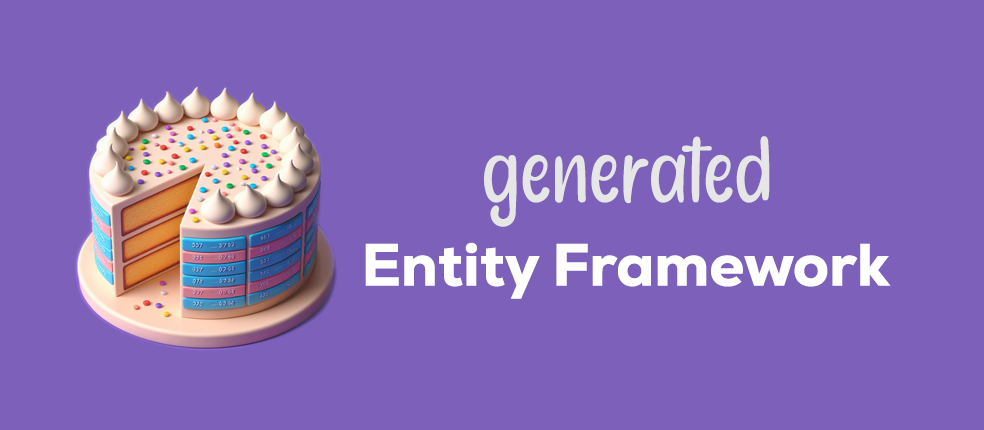GeneratedEntityFramework is a .NET source generator that automatically generates the DbSet implementations for a
DbContext based on the properties of an interface. This greatly facilitates integration of Entity Framework within a
Clean Architecture (CA) or a Vertical Slice Architecture (VSA) by segmenting one or more DbContexts into one or more
interfaces.
This source generator will generate source that is only compatible with EntityFrameworkCore and Microsoft's Dependency Injection abstraction.
Usually, a DbContext will contain or more DbSets:
public class BloggingContext : DbContext
{
public DbSet<Blog> Blogs { get; set; }
public DbSet<Post> Posts { get; set; }
}In a typical Clean Architecture project, those DbSets are often presented to the application as an interface:
public class BloggingContext : DbContext, IBloggingContext
{
public DbSet<Blog> Blogs { get; set; }
public DbSet<Post> Posts { get; set; }
}
public interface IBloggingContext
{
public DbSet<Blog> Blogs { get; }
public DbSet<Post> Posts { get; }
}Keeping both the DbContext and the interface up to date with each other can quickly become tedious as each
DbSet added to the interface must also be duplicated by hand in the DbContext and vice versa.
GeneratedEntityFramework's source generator solves this
by source generating a partial implementation of the DbContext based on it's association with one or more
interfaces.
The are three different ways for the source generator to detect which implementations to generate for the DbContext.
If the DbContext is marked with the GeneratedDbContext attribute, it will generate the implementations for all
of the inherited interfaces.
[GeneratedDbContext]
public partial class BloggingContext : DbContext, IBloggingContext
{
}
public interface IBloggingContext
{
public DbSet<Blog> Blogs { get; }
public DbSet<Post> Posts { get; }
}If the DbContext is marked with the GeneratedDbContext attribute and the interface is specified as the constructor
parameter, it will generate the implementations for the specified interface and automatically add the interface as
an inherited interface to the partial DbContext.
[GeneratedDbContext<IBloggingContext>]
public partial class BloggingContext : DbContext
{
}
public interface IBloggingContext
{
public DbSet<Blog> Blogs { get; }
public DbSet<Post> Posts { get; }
}If the interface is marked with the DbContext attribute and the DbContext is specified as the constructor
parameter, it will generate the implementations for the specified interface and automatically add the interface as
an inherited interface to the partial DbContext.
public partial class BloggingContext : DbContext
{
}
[DbContext<BloggingContext>]
public interface IBloggingContext
{
public DbSet<Blog> Blogs { get; }
public DbSet<Post> Posts { get; }
}Generic attributes are available from .NET 7.0 onwards, in order to use the GeneratedDbContext and DbContext
attributes with .NET 6.0 and prior, simply use the constructor with a typeof value of the interface or DbContext
as follows:
[GeneratedDbContext(typeof(IBloggingContext))]
public partial class BloggingContext : DbContext { }
[DbContext(typeof(BloggingContext))]
public interface IBloggingContext { }The GeneratedDbContext and DbContext attributes can be used multiple times in any combinations, the source generator
will automatically eliminate any duplication and redundancies. This is incredibly useful for Vertical Sliced Architecture
(VSA) as this allows different slices to define segmented interfaces while merging of all the implementations over a single
DbContext. For example, the following will produce a single implementation of each of the DbSets on the DbContext:
[GeneratedDbContext<IBloggingContext>]
[GeneratedDbContext<IBlogsContext>]
[GeneratedDbContext<IPostsContext>]
public partial class BloggingContext : DbContext
{
}
[DbContext<BloggingContext>]
public interface IBloggingContext
{
public DbSet<Blog> Blogs { get; }
public DbSet<Post> Posts { get; }
}
[DbContext<BloggingContext>]
public interface IBlogsContext
{
public DbSet<Blog> Blogs { get; }
}
[DbContext<BloggingContext>]
public interface IPostsContext
{
public DbSet<Post> Posts { get; }
}One of the issues with specifying DbSet in the interface is that it creates high coupling with Entity Framework and
negates the benefits of using an abstraction to access the database. As an alternative, if the interface specifies an
IQueryable property instead of a DbSet one, then a private DbSet property will be generated as a backing field
within the DbContext. Thus, the following:
[GeneratedDbContext<IBloggingContext>]
public partial class BloggingContext : DbContext
{
}
public interface IBloggingContext
{
public IQueryable<Blog> Blogs { get; }
public IQueryable<Post> Posts { get; }
}Would generate the following partial DbContext:
public partial class BloggingContext : IBloggingContext
{
private DbSet<Blog> DbSet__Blogs { get; set; } = default!;
public IQueryable<Blog> Blogs => DbSet__Blogs;
private DbSet<Post> DbSet__Posts { get; set; } = default!;
public IQueryable<Post> Posts => DbSet__Posts;
}If a DbSet exists on the interface for the same entity type as the IQueryable, that will be used instead of
creating a backing field. This allows both DbSet and IQueryable properties to be combined as needed like so:
[GeneratedDbContext<IBloggingContext>]
public partial class BloggingContext : DbContext
{
}
public interface IBloggingContext
{
public DbSet<Blog> BlogsDbSet { get; }
public IQueryable<Blog> Blogs { get; }
}Would instead generate the following partial DbContext:
public partial class BloggingContext : IBloggingContext
{
public DbSet<Blog> BlogsDbSet { get; set; } = default!;
public IQueryable<Blog> Blogs => BlogsDbSet;
}The AsNoTracking attribute can be added to IQueryable properties and .AsNoTracking() will added to the implementation.
[GeneratedDbContext<IBloggingContext>]
public partial class BloggingContext : DbContext
{
}
public interface IBloggingContext
{
public DbSet<Blog> BlogsDbSet { get; }
[AsNoTracking]
public IQueryable<Blog> Blogs { get; }
}Will generate the following partial DbContext:
public partial class BloggingContext : IBloggingContext
{
public DbSet<Blog> BlogsDbSet { get; set; } = default!;
public IQueryable<Blog> Blogs => BlogsDbSet.AsNoTracking();
}In the GeneratedEntityFramework namespace, an extension method named AddDbContextInterfaces is added which can be used
with the IServiceCollection to register all of the interfaces against their respective DbContexts.
public static void AddDbContextInterfaces(this IServiceCollection services)
{
services.AddScoped<IBlogsContext>(sp => sp.GetRequiredService<BloggingContext>());
services.AddScoped<IPostsContext>(sp => sp.GetRequiredService<BloggingContext>());
}With a host builder, simply call the extension method on the service collection.
builder.Services.AddDbContextInterfaces();By default, the service lifetime is the same as the Entity Framework default of Scoped. To specify a different service lifetime,
add the DbContextInterfaceLifetime attribute to the DbContext and any associated interfaces will be registered with the
specified lifetime.
[GeneratedDbContext<IBloggingContext>]
[DbContextInterfaceLifetime(ServiceLifetime.Transient)]
public partial class BloggingContext : DbContext
{
}


